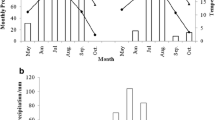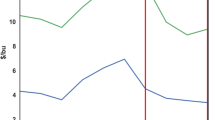Abstract
Bioenergy sorghum [Sorghum bicolor (L). Moench.] is a potential dedicated energy crop that can help fulfill requirements for advancing ligno-cellulosic biofuel technology, but information balancing profitability and soil resource effects of growing this crop is limited. Using field plot data, this study objective is to quantify effects of different bioenergy sorghum management practices on soil characteristics that influence yield and ultimately the producer’s net return. Field studies were conducted at the Texas A&M AgriLife Research Farm near College Station, TX from 2008 through 2011. A stochastic economic simulation model was developed using yields and associated soil characteristics data. Results suggested growing bioenergy sorghum may be profitable and can achieve a maximum annual net return to capital, land, and management of $1,600 ha−1 by applying 300 kg ha−1 of nitrogen and returning no biomass. This net return, however, is achieved at the cost of soil carbon and nitrogen depletion. The soil nutrient pool was maintained when biomass return rates were approximately 20 % of yield. This management practice, however, requires a compromise of $330 to $422 ha−1 in net returns compared to a 0 % biomass return.





Similar content being viewed by others
References
Larson ED (2008) Biofuel production technologies: status, prospects and implications for trade and development. United Nations Conference on Trade and Development. http://www.unctad.org/en/docs/ditcted200710_en.pdf. Accessed 26 Sept 2013
Wilhelm WW, Johnson JMF, Hatfield JL, Voorhees WB, Linden DR (2004) Crop and soil productivity response to corn residue removal: a literature review. Agron J 96(1):1–17
Amosson S, Girase J, Bean B, Rooney W, Becker J (2011) Economic analysis of biomass sorghum for biofuels production in the Texas High Plains. Texas A&M AgriLife Research and Extension Center, Amarillo, http://amarillo.tamu.edu/files/2011/05/Biomass-Sorghum.pdf. Accessed 25 Sept 2013
Blade Energy Corp (2010) Managing high-biomass sorghum as a dedicated energy crop. http://www.bladeenergy.com/Bladepdf/Blade_SorghumMgmtGuide2010.pdf. Accessed 25 Sept 2013
Wight JP, Hons FM, Storlien JO, Provin TL, Shahandeh H, Wiedenfeld RP (2012) Management effects on bioenergy sorghum growth, yield and nutrient uptake. Biomass Bioenergy 46:593–604
Lal R, Follett RF, Kimble JM (2003) Achieving soil carbon sequestration in the United States: a challenge to the policy makers. Soil Sci 168:827–845
Conant RT, Paustian K, Elliott ET (2002) Pastureland use in the southeastern US: implications for carbon sequestration. In: Lal R, Follet RF, Kimble JM (eds) Agricultural practices and policies for carbon sequestration in soil. CRC Press, Boca Raton, pp 423–432
Franzluebbers AJ (2010) Achieving soil organic carbon sequestration with conservation agricultural systems in the Southeastern United States. Soil Sci Soc Am J 74:47–357
Smith WN, Grant BB, Campbell CA, McConkey BG, Desjardins RL, Kröbel R, Malhi SS (2012) Crop residue removal effects on soil carbon: measured and inter-model comparisons. Agric Ecosyst Environ 161:27–38
Lu M, Zhou X, Luo Y, Yang Y, Fang C, Chen J, Li B (2011) Minor stimulation of soil carbon storage by nitrogen addition: a meta-analysis. Agric Ecosyst Environ 140(1–2):234–244
Vitousek PM, Howarth RW (1991) Nitrogen limitation on land and in the sea—how can it occur? Biogeochemistry 13:87–115
Zanatta JA, Bayer C, Dieckow J, Vierira FCG, Mielniczk J (2007) Soil organic carbon accumulations and carbon costs related to tillage, cropping systems and nitrogen fertilization in a subtropical Acrisol. Soil Tillage Res 94(2):610–619
Studdert GA, Echeverr HE (2000) Crop rotations and nitrogen fertilization to manage soil organic carbon dynamics. Soil Sci Soc Am J 64(4):1496–1503
Srinivasarao C, Deshpande AN, Venkateswarlu B, Lal R, Singh AK, Kundu S, Vittal KPR, Mishra PK, Prasad JVNS, Mandal UK, Sharma KL (2012) Grain yield and carbon sequestration potential of post monsoon sorghum cultivation in Vertisols in the semi arid tropics of central India. Geoderma 175:90–97
Sainju UM, Singh BP, Whitehead WF (2005) Tillage, cover crops, and nitrogen fertilization effects on cotton and sorghum root biomass, carbon, and nitrogen. Agron J 97(5):1279–1290
Khan SA, Mulvaney RL, Ellsworth TR, Boast CW (2007) The myth of nitrogen fertilization for soil carbon sequestration. J Environ Qual 36(6):1821–1832
Larson WE, Clapp CE, Pierre WH, Morachan YB (1972) Effects of increasing amounts of organic residues on continuous corn: II organic carbon, nitrogen, phosphorus and sulfur. Agron J 64(2):204–208
Rasmussen PE, Allmaras RR, Rohde CR, Roager NC (1980) Crop residue influences on soil carbon and nitrogen in a wheat-fallow system. Soil Sci Soc Am J 44(3):596–600
Bullock LR III, Brosius M, Evanylo GK, Ristaino JB (2002) Organic and synthetic fertility amendments influence soil microbial, physical and chemical properties on organic and conventional farms. Appl Soil Ecol 19(2):47–160
Spargo JT, Evanylo GK, Alley MM (2006) Repeated compost application effects on phosphorus runoff in the Virginia Piedmont. J Environ Qual 35(6):2342–2351
Reicosky DC, Evans SD, Cambardella CA, Allmaras RR, Wilts AR, Huggins DR (2002) Continuous corn with moldboard tillage: residue and fertility effects on soil carbon. J Soil Water Conserv 57(5):277–284
Molina JAE, Clapp CE, Linden DR, Allmaras RR, Layese MF, Dowdy RH, Cheng HH (2001) Modeling the incorporation of corn (Zea maize L.) carbon from roots and rhizodeposition into soil organic matter. Soil Biol Biochem 33(1):83–92
Six J, Feller C, Denef K, Ogle SM, de Moraes JC, Albrecht A (2002) Soil organic matter, biota, and aggregation in temperate and tropical soils—effects of no-tillage. Agronomie 22:755–775
Balesdent J, Balabane M (1996) Major contribution of roots to soil carbon storage inferred from maize cultivated soils. Soil Biol Biochem 28(9):1261–1263
Rasse DP, Rumpel C, Dignac MF (2005) Is soil carbon mostly root carbon? Mechanisms for a specific stabilization. Plant Soil 269(1–2):341–356
VandenBygaart AJ, Bremer E, McConkey BG, Ellert BH, Janzen HH, Angers DA, Carter MR, Drury CF, Lafond GP, McKenzie RH (2011) Impact of sampling depth on differences in soil carbon stocks in long-term agroecosystem experiments. Soil Sci Soc Am J 75(1):226–234
Ellert BH, Janzen HH, VandenBygaart AJ, Bremer E (2007) Measuring change in soil organic carbon storage. In: Carter MR, Gregorich EG (eds) Soil sampling and methods of analysis, 2nd edn. CRC Press, Boca Raton, pp 25–38
VandenBygaart AJ (2006) Monitoring soil organic carbon stock changes in agricultural landscapes: issues and a proposed approach. Can J Soil Sci 86(3):451–463
VandenBygaart AJ, Gregorich EG, Angers DA, McConkey BG (2007) Assessment of the lateral and vertical variability of soil organic carbon. Can J Soil Sci 87(4):433–444
Mjelde JW, Cothren JT, Rister ME, Hons FM, Coffman CG, Shumway CR, Lemon RG (1991) Integrating data from various field experiments: the case of corn in Texas. J Prod Agric 4:139–147
Sainju UM, Lenssen AW, TonThat TC, Jabro JD, Lartey RT, Evans RG, Allen BL (2001) Dryland residue and soil organic matter as influenced by tillage, crop rotation, and cultural practice. Plant Soil 338(1–2):27–41
Richardson JW, Schumann K, Feldman P (2008) Simulation & econometrics to analyze risk (Simetar). Simetar, Inc, College Station, http://simetar.com/
Texas A&M AgriLife Center (2013) Bioenergy sorghum publications. Available at http://amarillo.tamu.edu/amarillo-center-programs/agronomy/bioenergy-sorghum. Accessed 26 Sept 2013
USDA, Economic Research Service (2013) Average U.S. farm prices of selected fertilizers, 1960–2012. http://www.ers.usda.gov/data-products/fertilizer-use-and-price.aspx#.UmkvHVPZWvQ. Accessed 25 Sept 2013
USDA, Economic Research Service (2013) U.S. Bioenergy Statistics. http://www.ers.usda.gov/data-products/us-bioenergy-statistics.aspx#.UmbszfmUQfU. Accessed 25 Sept 2013
Antle JM, Capalbo SM, Elliott ET, Paustian KH (2001) Economic analysis of carbon sequestration in agricultural soils: an integrated assessment approach. J Agric Res Econ 26(2):344–367
Lal R (2003) Achieving soil carbon sequestration in the United States: a challenge to the policy makers. Soil Sci 168(567):827–845
Blanco-Canqui H (2013) Crop residue removal for bioenergy reduces soil carbon pools: how can we offset carbon losses? Bioenergy Res 6(1):358–371
Acknowledgments
Funding for this research by USDA AFRI (grant #2011-67009-30050) and Texas A & M AgriLife Research is gratefully acknowledged.
Author information
Authors and Affiliations
Corresponding author
Rights and permissions
About this article
Cite this article
Amatya, P., Wight, J., Mjelde, J.W. et al. Balancing Bioenergy and Soil Productivity Returns for Sustainable Biomass Sorghum [Sorghum bicolor (L). Moench.] Production. Bioenerg. Res. 7, 1144–1154 (2014). https://doi.org/10.1007/s12155-014-9451-7
Published:
Issue Date:
DOI: https://doi.org/10.1007/s12155-014-9451-7




